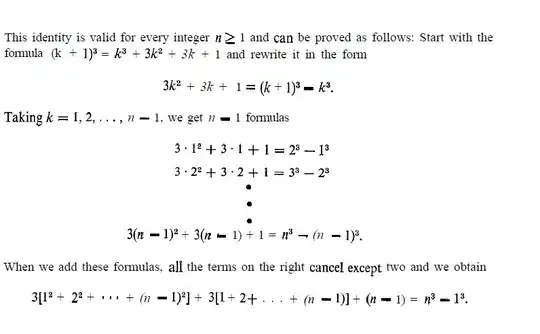I'm having a difficulty understanding this

It's only the addition part which I'm not following.
From what I've understood:
If we have a certain number of formulas and we add them, this is what happens on the left side:
$$3\cdot 1^2+3\cdot 2^2+\cdots+3\cdot (n-1)^2=3\cdot(1^2+2^2+\cdots+(n-1)^2)$$
$$3\cdot 1+3\cdot 2+\cdots +3\cdot (n-1)=3\cdot (1+2+\cdots+(n-1))$$
and we know that when we have a sequence of formulas, it will be $(n-1)$ formulas, so we represent the total numbers of $1$'s in the form $(n-1)$
Finally,
$$3(1^2+2^2+\cdots+(n-1)^2)+3(1+2+\cdots+(n-1))+(n-1)=\cdots$$
Now, for the right hand side, if we have, as an example:
$$2^3-1^3$$
$$3^3-2^3$$
$$4^4-3^3$$
$$n^3-4^3$$
We can reorganize this:
$$2^3-1^3$$
$$-2^3+3^3$$
$$4^4-3^3$$
$$n^3-4^3$$
We cancel which leaves us with
$$0-1^3$$
$$4^4+0$$
$$n^3-4^3$$
Rearrange and cancel:
$$0-1^3$$
$$0+4^4$$
$$n^3-4^3$$
Which leaves us with
$$n^3-1^3$$
Finally $$3\cdot(1^2+2^2+\cdots+(n-1)^2)+3\cdot(1+2+\cdots+(n-1))+(n-1)=n^3-1^3$$ The author doesn't say how exactly he did it, but would this way be the correct one? Or it's not the correct way?
Thank you!